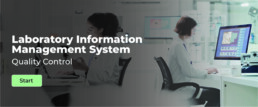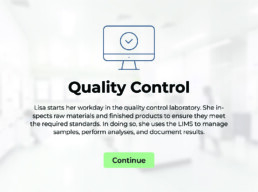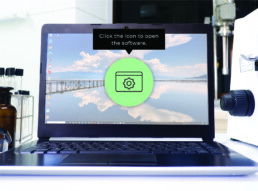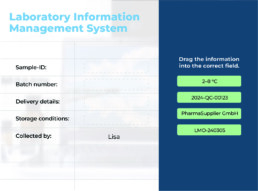
LIMS training
Mastering complex systems with ease
Precision counts in the laboratory – not only in analysis, but also in data acquisition and documentation. To ensure that everything runs smoothly, many companies use a LIMS (Laboratory Information and Management System). This also applies to Lisa, a new employee in quality control. But how do you efficiently familiarize new colleagues with such an extensive system – without overwhelming them with technical terms and masks? Our answer: targeted LIMS training in the form of e-learning. In this best practice, we show how we use authentic use cases, interactive elements and a clear didactic concept to make even complex software understandable.
Initial situation digitization
The problem
New employees in quality control are faced with a multitude of tasks right from the start – and a system that digitally maps all of these tasks: the LIMS. It is central to the management of samples, the performance of analyses and the complete documentation of results. However, the system often seems overwhelming, especially at the beginning: many functions, many technical terms, many processes. This is exactly where our LIMS training comes in. Instead of explaining technical functions in isolation, we pick up users like Lisa directly in their day-to-day work – and turn abstract masks into tangible use cases.


Skillpractice
The solution
In our LIMS training, learners start directly where Lisa starts: at the computer in the quality control laboratory. With one click, they are immersed in an interactive simulation of the LIMS software and are guided step by step through the relevant functions – from creating new samples to selecting suitable analysis methods and reliably documenting the results. Users experience typical application scenarios and make decisions that influence the further course of the process. This practical approach and interactive elements turn a classic system introduction into a memorable learning experience – and the LIMS becomes a familiar tool in everyday working life.

Storytelling meets job reality - scalable and practical
Especially in LIMS training, storytelling helps to convey complex content in an understandable way. By basing the story on the specific tasks of individual job roles, e-learning remains close to everyday working life – and flexible at the same time: new roles or processes can be added without having to rethink the entire training.
In the following examples, no current LIMS software interface is shown.

Job role quality control
Manage samples efficiently
A central element of every LIMS training course is sample management – because this is where it is decided whether analyses can be carried out in a traceable and standard-compliant manner. In our e-learning course, employees like Lisa learn how to create new samples in the system, assign them to the correct analyses and document all information in an audit-proof manner. The original LIMS interface allows all steps to be practiced realistically – without any risk. This creates confidence in using the software before things get serious in the real laboratory.
Making success visible
Complete LIMS training and use it safely
Whether it’s sample preparation, analysis selection or documentation – every task in the LIMS training course is designed to be practical and tests exactly the knowledge that counts in day-to-day work. The result: final feedback that shows which areas have already been mastered and where there is still potential for improvement. Learners can see at a glance how well prepared they are – and go into their first real use of the system feeling confident.

Storytelling and interactivity turn complex software into a tangible learning experience. This not only makes learning faster - but also more sustainable.

Interview with Günther Veit
Why did you decide to implement LIMS training as e-learning?
LIMS is the central system in many laboratories – nothing works without it. At the same time, it is complex to use and often seems like a labyrinth to new employees. We wanted to show how this barrier to entry can be overcome – and chose a typical onboarding situation from quality control as the starting point. This turned the dry system introduction into a practical learning concept.
What was the biggest challenge in designing the e-learning program?
The balancing act between technical correctness and didactic comprehensibility. LIMS consists of many individual functions, but it must be clear for the training: What is really relevant for which job role? That’s why we rely on storytelling – in our case, we accompany Lisa, the new colleague in quality control, through her first day at work. In this way, we always convey functions in the context of a specific task.
You talk about storytelling - what other advantages does your LIMS training offer as e-learning?
The great strength lies in the interactivity. Our LIMS training allows learners to work directly with a simulated system interface. They make decisions, manage samples, document analyses – and receive immediate feedback. This motivates and ensures a deeper understanding. Our didactic concept is also scalable: New roles or process changes can be added without redesigning the entire training.
How does the company benefit from digitizing LIMS training?
Firstly, of course, efficiency: training can be carried out at any time and from any location. New employees are up to speed more quickly and refresher courses can also be implemented flexibly. Secondly, the quality of the application increases: When employees understand the LIMS better, fewer errors occur – and this saves time and money in the long term. And last but not least, well thought-out digital onboarding also strengthens employer branding.
Online cybersecurity training – necessary and meaningful
Cybersecurity training online is not only possible, but more effective than expected - if…
Cybersecurity training online: What training should really achieve
A modern online cybersecurity training must do more than just warn. How e-learning…
e-Learning IT security: Why standard courses do not protect
e-Learning IT Security: How customized e-Learnings build awareness and real protection…
Online cybersecurity course for managers: responsibility starts at the top
Managers need customized online cybersecurity courses - for real responsibility and…
Online cybersecurity course: Why awareness alone is not enough
Online cybersecurity course: Strategic guidance for cybersecurity training. Why awareness…
IT security online course: these 5 mistakes to avoid
IT security online course: These mistakes should be avoided during development in order…
Cybersecurity online training with storytelling for real awareness
Cybersecurity online training with storytelling creates real awareness - why HR and…
Cybersecurity online course as a well thought-out curriculum
Curriculum-based cybersecurity online course concept: customized, adaptive content,…
Information security training as e-learning: protection for companies
Discover how customized information security training via e-learning works for large…









